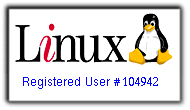| Many X-specific applications have been written, including games, graphics
and programming utilities, and documentation tools. Linux and X make your
system a bona fide workstation. With TCP/IP networking, your Linux machine
can display X applications running on other machines.
The X Window System was originally developed at the Massachusetts Institute
of Technology and is freely distributable. Many commercial vendors have
distributed proprietary enhancements to the original X Window System as
well. The version of X for Linux is XFree86, a port of X11R6 which is freely
distributable. XFree86 supports a wide range of video hardware, including
VGA, Super VGA, and accelerated video adaptors. XFree86 is a complete distribution
of the X Windows System software,
and contains the X server itself, many applications and utilities,
programming libraries, and documents.
Standard X applications include xterm, a terminal emulator used for
most text-based applications within a window, xdm, which handles logins,
xclock, a simple clock display, xman, a X-based manual page reader, and
xmore. The many X applications available for Linux are too numerous to
mention here, but their number includes spreadsheets, word processors,
graphics programs, and web browsers like the Netscape Navigator. Many other
applications are available separately. Theoretically, any application written
for X should compile cleanly under Linux.
The interface of the X Window System is controlled largely by the window
manager. This user-friendly program is in charge of the placement of windows,
the user interface for resizing and moving them, changing windows to icons,
and the appearance of window frames, among other tasks. XFree86 includes twm,
the classic MIT window manager, and advanced window managers like the Open
Look Virtual Window Manager (olvwm)
are available. Popular among Linux users is fvwm--a
small window manager that requires less than half the memory of twm. It
provides a 3-dimensional appearance for windows and a virtual desktop.
The user moves the mouse to the edge of the screen, and the desktop shifts
as though the display were much larger than it really is. fvwm is greatly
customizable and allows access to functions from the keyboard as well as
mouse. Many Linux distributions use fvwm as the standard window manager.
A version of fvwm called fvwm95-2
offers Microsoft Windows 95-like look and feel.
The XFree86 distribution includes programming libraries for wily programmers
who wish to develop X applications. Widget sets like Athena, Motif Window
Manager(Mwm), Open Look, and
Xaw3D are supported. All of the standard fonts, bitmaps, manual pages,
and documentation are included. PEX (a programming interface for 3-dimensional
graphics) is also supported.
Many X application programmers use the proprietary Motif widget set
for development. Several vendors sell single and multiple user licenses
for binary versions of Motif. Because Motif itself is relatively expensive,
not many Linux users own it. However, binaries statically linked with Motif
routines can be freely distributed. If you write a program using Motif,
you may provide a binary so users without the Motif libraries can use the
program.
A major caveat to using the X Window System is its hardware requirements.
A 80386-based CPU with 4 megabytes of RAM is capable of running X, but
16 megabytes or more of physical RAM is needed for comfortable use. A faster
processor is nice to have as well, but having enough physical RAM is much
more important. In addition, to achieve really slick video performance,
we recommend getting an accelerated video card, like a VESA Local Bus (VLB)
S3 chipset card. Performance ratings in excess of 300,000 xstones have
been achieved with Linux and XFree86. Using adequate hardware, you'll find
that running X and Linux is as fast, or faster, than running X on other
UNIX workstations.
|




